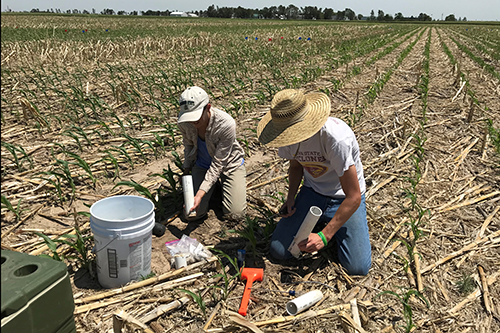
When Too Much of a Good Thing Becomes a Bad Thing
Researchers examine the question: Should you add more nitrogen when limiting irrigation?
As farmers grapple with worsening drought, they have begun to explore ways to grow crops with less water. One strategy they’ve started to use in recent years is limited irrigation, in which crops still receive some water via irrigation, but less than the full amount needed. The approach brings many questions, foremost among them: when you change one input, what should you do with the others?
After water, one of the most important elements that plants need is the nitrogen that fertilizes them, supporting their growth. But how much nitrogen should farmers provide to plants that are getting less water? One idea is that farmers should reduce the amount of fertilizer proportionally to the reduction in water. However, many farmers, fearing the harm that reduced water might cause to their crops, leave nitrogen levels higher, in the hope that the extra fertilizer will partially offset the problems caused by the decreased water levels. A team of ARS scientists set out to examine how changes in the levels of water and nitrogen interact, and what that may mean for farmers who want to do right by their crops, their pocketbooks, and the environment.
In a recent paper, they examined the effects of applying different levels of water and fertilizer, comparing the results for yields, nitrogen runoff, greenhouse gas emissions, and more. What they found was in some ways surprising.
In multiple experiments, the team discovered that even a little extra nitrogen can hurt yield. As a result, they came to recommend not applying more than the minimum amount of nitrogen needed by the crop when limiting irrigation, especially as fertilizer gets more expensive.
"You are basically leaving a pool of nitrogen behind that will get into the environment one way or another," said researcher Louise Comas, a research plant physiologist at the Water Management and Systems Research Unit in Fort Collins, CO.
 Julia Young measuring chlorophyll fluorescence as a measurement of photosynthetic efficiency at the Limited Irrigation Research Farm. (Photo by Nora Flynn, USDA)
Julia Young measuring chlorophyll fluorescence as a measurement of photosynthetic efficiency at the Limited Irrigation Research Farm. (Photo by Nora Flynn, USDA)
"It's a double negative for the producer," she added. "They are paying for nitrogen, and as those costs go up, they’re paying for something that’s actually hurting their bottom line."
In their experiments, the researchers tried to minimize nitrogen loss, applying the fertilizer over time, in multiple separate, small installments.
"The advantage of doing a split application is that you’re matching to plant demand. Broadcasting typically goes on fairly early, either before planting or when the plants are pretty small, so there’s less ability for the plant to take up the nitrogen, and a larger risk of loss," said Catherine Stewart, a research soil scientist at the Soil Management and Sugarbeet Research Unit in Fort Collins, CO.
The results suggested that with nitrogen levels appropriately matched, the reduced water systems might offer some benefits. "We do see with deficit irrigation, and also with drip, that we have less greenhouse gas emissions than with other systems," Stewart said.
The team also investigated subsurface leaching of nitrate, and found 30% more nitrogen deep in the soil profile (30-90 cm) at the end of the season under limited water availability than under full water availability. This result, they said, emphasizes the need to get fertilizer requirements right no matter what the water availability, in order to reduce nitrogen losses to the environment; their findings could play a role in a future revision of nitrogen recommendations.
 Colorado State University collaborators Meagan Schipanski and Tyler Donovan installing incubation tubes to measure soil nitrogen mineralization in a continuing experiment. (Photo by Louise Comas, ARS)
Colorado State University collaborators Meagan Schipanski and Tyler Donovan installing incubation tubes to measure soil nitrogen mineralization in a continuing experiment. (Photo by Louise Comas, ARS)
For now, though, there are still many questions about how best to navigate a world of reduced inputs.
Comas noted that plants currently get about half their nitrogen needs met through naturally-occurring soil processes — processes the team would like to better understand.
"How plants interact through their root systems, how they support microbes, and how the nitrogen and water interact with the carbon coming in from plants in these processes, is a very important part of this equation,” she said. “What we’d like in the end is to fertilize less and to be able to harness those natural processes more."
The team is looking into these additional questions in collaboration with researchers at Colorado State University.
And, as their exploration continues, the researchers are finding ever more complexity in the web of interactions that drives plant growth and wellbeing. "One of the things that we’re learning is that there’s a background timing, independent of the management of water and nitrogen,” said Comas. “There is a seasonal component to that nitrogen mineralization that may work better for some crops than others—but we have a lot more to learn." — by Kathryn Markham, ARS Office of Communications
